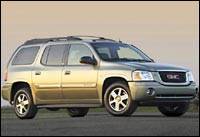In a perfectworld, vehicles that use different sizes of engines depending upon thesituation at hand would be the way to go.
So your SUV woulduse a 5-litre V-8 to get itself moving from a stoplight, a 3.8-litre V-6 toleapfrog a slow-moving truck, a 2.4-litre inline-four to conquer a smallincline in the road, and a 1-litre inline-two to maintain a steady speed alonga highway.
Thus would beachieved the perfect balance between performance and fuel economy, as theengine continuously reconfigured itself to offer precisely the right enginesetup for the changing reality.
While it's not aperfect world just yet, automotive technology has evolved to the point wheresomething like the multi-displacement engine is at hand. It is in factavailable in a handful of new products now, including the 2005 GMC Envoy XL,which I recently drove from Toronto to Ottawa and back by way of Kingston tosee what the technology was like.
Before we get tothat, however, it's worth mentioning the other vehicles that have engines thatshut off cylinders when they're not needed, which is the only way to deliverthe multiple-displacement dream. What I say about the technology in the EnvoyXL will apply to these other vehicles, though of course the precise fueleconomy improvements will vary.
GM usesvariable-displacement in the V-8 versions of Envoy XL and the ChevroletTrailblazer, Mercedes-Benz in the S500, Honda in the Odyssey and the AccordHybrid, and Chrysler in V-8 Hemi iterations of the Chrysler 300, the DodgeMagnum RT, and Jeep Grand Cherokee.
While eachcompany uses a different nickname to describe the technology, they all promisethe same thing -- the engine will deliver maximum power when you want it to orwhen it's needed, and maximum fuel economy when it gets the chance.
While eachcompany is also able to promise specific numbers for its multi-displacementengine's maximum power output, no one is able to promise anything aboutimproved fuel economy because it varies from driver to driver and situation tosituation.
The best theycan do is make generalizations on the fuel economy savings based on the testingcycles of either the U.S. or Canadian government, and everyone knows thosenumbers are only good for comparing one vehicle against another on a standarddriving pattern, not projecting real-world fuel use.
So no company isgoing to promise you a specific improvement in fuel economy since that dependsalmost entirely on the situation and the driver's attitude.
Looking atTransport Canada's fuel economy numbers does suggest the value of what GM callsits Displacement On Demand (DOD) technology. In the four-wheel-drive Envoy XL,the more powerful 5.3-litre V-8 actually gets better fuel economy ratings thanthe 4.2-litre inline-six.
This turnsengineering reality on its head, since more displacement, more cylinders andmore power results in less fuel economy and that's just the way it is. That isstill the almost universally true, although a really new and sophisticatedengine can sometimes give an old powerplant a run for its money.
So your SUV woulduse a 5-litre V-8 to get itself moving from a stoplight, a 3.8-litre V-6 toleapfrog a slow-moving truck, a 2.4-litre inline-four to conquer a smallincline in the road, and a 1-litre inline-two to maintain a steady speed alonga highway.
Thus would beachieved the perfect balance between performance and fuel economy, as theengine continuously reconfigured itself to offer precisely the right enginesetup for the changing reality.
 |
Before we get tothat, however, it's worth mentioning the other vehicles that have engines thatshut off cylinders when they're not needed, which is the only way to deliverthe multiple-displacement dream. What I say about the technology in the EnvoyXL will apply to these other vehicles, though of course the precise fueleconomy improvements will vary.
GM usesvariable-displacement in the V-8 versions of Envoy XL and the ChevroletTrailblazer, Mercedes-Benz in the S500, Honda in the Odyssey and the AccordHybrid, and Chrysler in V-8 Hemi iterations of the Chrysler 300, the DodgeMagnum RT, and Jeep Grand Cherokee.
While eachcompany uses a different nickname to describe the technology, they all promisethe same thing -- the engine will deliver maximum power when you want it to orwhen it's needed, and maximum fuel economy when it gets the chance.
While eachcompany is also able to promise specific numbers for its multi-displacementengine's maximum power output, no one is able to promise anything aboutimproved fuel economy because it varies from driver to driver and situation tosituation.
The best theycan do is make generalizations on the fuel economy savings based on the testingcycles of either the U.S. or Canadian government, and everyone knows thosenumbers are only good for comparing one vehicle against another on a standarddriving pattern, not projecting real-world fuel use.
So no company isgoing to promise you a specific improvement in fuel economy since that dependsalmost entirely on the situation and the driver's attitude.
Looking atTransport Canada's fuel economy numbers does suggest the value of what GM callsits Displacement On Demand (DOD) technology. In the four-wheel-drive Envoy XL,the more powerful 5.3-litre V-8 actually gets better fuel economy ratings thanthe 4.2-litre inline-six.
This turnsengineering reality on its head, since more displacement, more cylinders andmore power results in less fuel economy and that's just the way it is. That isstill the almost universally true, although a really new and sophisticatedengine can sometimes give an old powerplant a run for its money.

